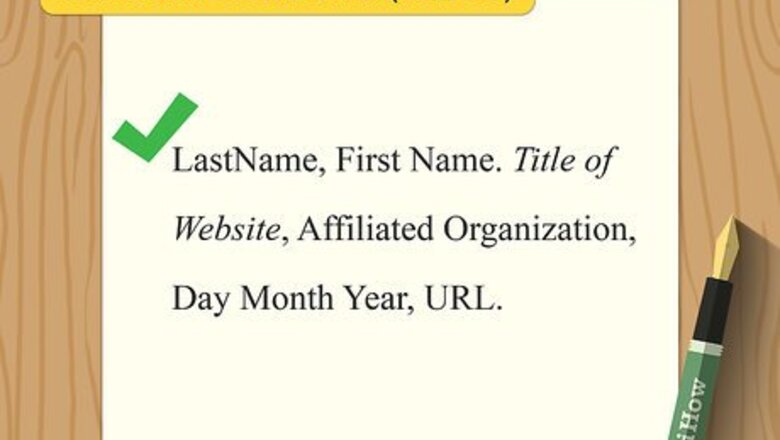
views
MLA

Start your Works Cited entry with the author's name if known. If the author of the website is an individual, list their last name first, followed by a comma, then their first name. For institutional authors, list the full name of the organization. Individual author example: Lovegood, Luna. Institutional author example: Wizarding World Publications.
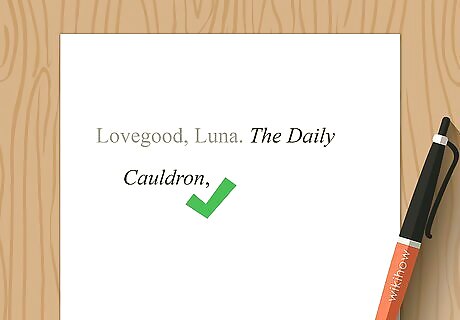
Provide the title of the website and the affiliated organization. Type the title of the website in title case, capitalizing all nouns, pronouns, adjectives, adverbs, and verbs. Place a comma after the website. If the website has an affiliated organization that is not the same as the author of the website, type that in regular font after the name of the website. Place a comma after the name of the organization. Example: Lovegood, Luna.The Daily Cauldron, Wizarding World Publications,

Include the date the site was last updated or modified. You may see a date the website was last updated at the top of the page. Otherwise, scroll down to the bottom and use the copyright year for the website. Type the date in day-month-year format, abbreviating the names of months that are longer than 4 letters. If you only have the year, list only the year and don't worry about the rest. Place a comma after the year. Example: Lovegood, Luna.The Daily Cauldron, Wizarding World Publications, 18 May 2019,
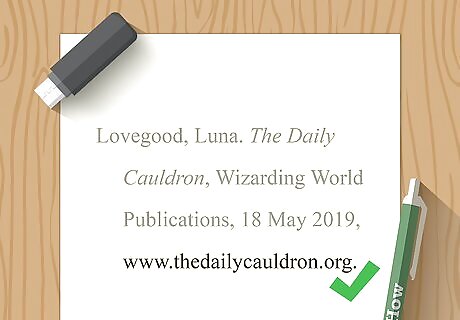
Close with the URL for the website. If your entry is for the entire website, use the URL for the homepage of the website. Do not include the "http://" part of the URL. Place a period at the end of the URL. Example: Lovegood, Luna.The Daily Cauldron, Wizarding World Publications, 18 May 2019, www.thedailycauldron.org. MLA Works Cited Format – Website LastName, First Name. Title of Website, Affiliated Organization, Day Month Year, URL.
APA
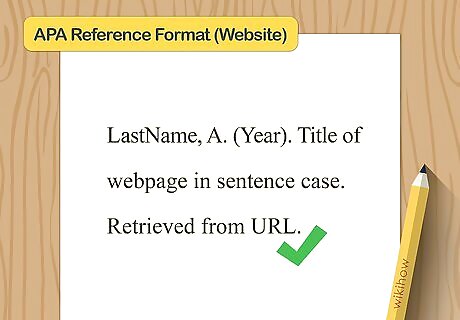
Include the URL for the site in your paper if you're citing the entire website. Unlike other citation formats, the APA does not require a reference list entry if you're citing an entire website. Instead, put the URL for the site in parentheses after you mention it in your text. For example, you might write "The Daily Cauldron provides muggles with insight into happenings in the wizarding world."
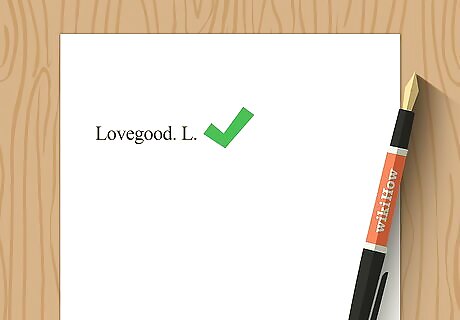
Start a reference list entry for a webpage with the author's name. If you're citing a specific webpage rather than a website as a whole, you do need a reference list entry. Type the last name of the author followed by a comma. Then type the author's first initial. If there is no author's name, list the title of the webpage first instead. Example: Lovegood. L.
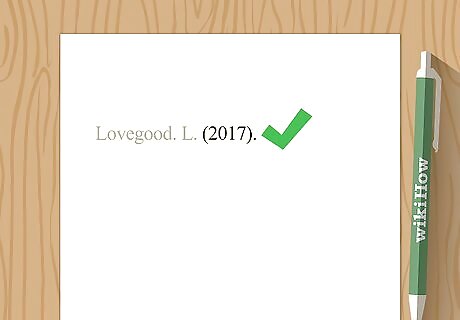
Provide the year of publication in parentheses. The year of publication is the year of the specific webpage, not the copyright date for the website as a whole. If there is no date for the specific webpage, use the abbreviation "n.d." Place a period outside the closing parenthesis. Example: Lovegood. L. (2017).

Add the title of the webpage. Type out the full title of the webpage in sentence case, capitalizing only the first word and any proper nouns in the title. Place a period at the end of the title. Example: Lovegood. L. (2017). Voldemort's influence among teachers and students at Hogwarts.
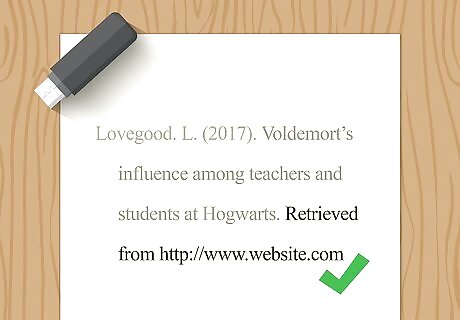
Close with a URL for the specific webpage. Type the words "Retrieved from" followed by the URL. Use the direct URL or permalink for the specific webpage. Do not place a period at the end of the URL. Example: Lovegood. L. (2017). Voldemort's influence among teachers and students at Hogwarts. Retrieved from http://www.thedailycauldron.org/V_influence_Hogwarts APA Reference List Format – Webpage LastName, A. (Year). Title of webpage in sentence case. Retrieved from URL.
Chicago
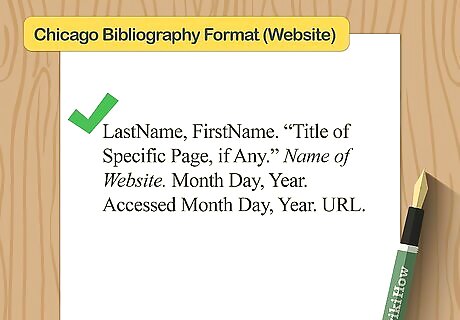
Start your entry with the author of the website. For individual authors, type their last name first followed by a comma. Then type their first name. For institutional authors, type the full name of the institution that claims authorship of the content on the website. Place a period at the end of the name. Example: Lovegood, Luna.
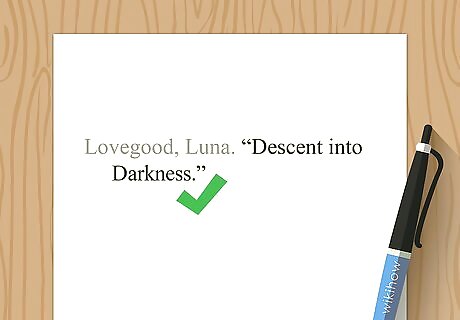
Include the title of the specific page in quotation marks. If you're referencing a specific page on the website, rather than the website as a whole, include it in your bibliographic entry. Type the title in title case, capitalizing all nouns, pronouns, adjectives, adverbs, and verbs. Place a period at the end of the title inside the closing quotation marks. Example: Lovegood, Luna. "Descent into Darkness."
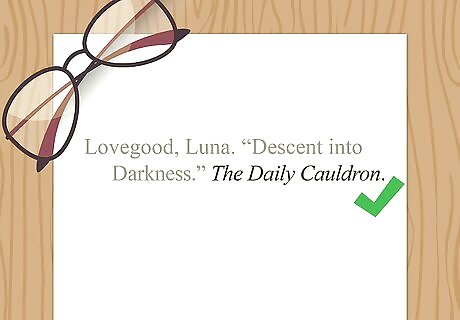
Provide the name of the website. Type the name of the website in italics, using title case. If you're referencing the website as a whole, this element would follow the author's name. Place a period at the end of the name of the website. Example: Lovegood, Luna. "Descent into Darkness." The Daily Cauldron.
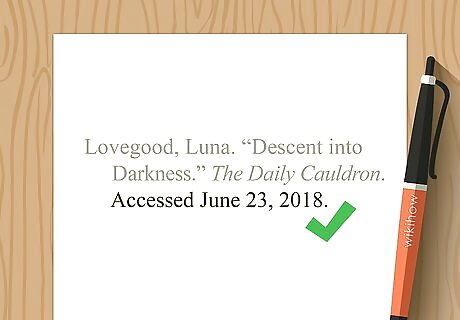
List the publication date and date of access. If the website has a publication date, enter it in month-day-year format, followed by a period. Abbreviate the names of months that are longer than 4 letters. Then type the word "Accessed" followed by the date you last accessed the website using the same date format. Place a period after the date of access. Example: Lovegood, Luna. "Descent into Darkness." The Daily Cauldron. Accessed June 23, 2018.
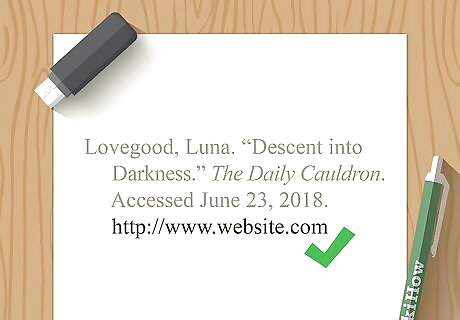
Close your bibliographic entry with the URL. If you're referencing a specific page, use the URL for that specific page. Otherwise, use the URL for the home page of the website. Place a period at the end of the URL. Example: Lovegood, Luna. "Descent into Darkness." The Daily Cauldron. Accessed June 23, 2018. http://www.thedailycauldron.org/descent. Chicago Bibliography Format – Website LastName, FirstName. "Title of Specific Page, if Any." Name of Website. Month Day, Year. Accessed Month Day, Year. URL.



















Comments
0 comment